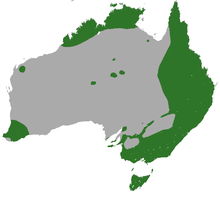
Back بوسوم كث الذيل Arabic بوسوم كث الذيل ARZ Ekibol (Trichosurus vulpecula) AVK تریچوسوروس وولپکولا AZB Четкоопашат посум Bulgarian Pòssum comú Catalan Trichosurus vulpecula CEB Kusu liščí Czech Fuchskusu German Vulpoposumo Esperanto
| Common brushtail possum[1] | |
|---|---|

| |
| At Austins Ferry, Tasmania | |
| Scientific classification | |
| Domain: | Eukaryota |
| Kingdom: | Animalia |
| Phylum: | Chordata |
| Class: | Mammalia |
| Infraclass: | Marsupialia |
| Order: | Diprotodontia |
| Family: | Phalangeridae |
| Genus: | Trichosurus |
| Species: | T. vulpecula
|
| Binomial name | |
| Trichosurus vulpecula | |
| Subspecies | |
|
T. v. vulpecula (South-eastern common brushtail possum and central brushtail possum) | |

| |
| Common brushtail possum native range | |
The common brushtail possum (Trichosurus vulpecula, from the Greek for "furry tailed" and the Latin for "little fox", previously in the genus Phalangista[4]) is a nocturnal, semiarboreal marsupial of the family Phalangeridae, native to Australia and invasive in New Zealand, and the second-largest of the possums.
Like most possums, the common brushtail possum is nocturnal. It is mainly a folivore, but has been known to eat small mammals such as rats. In most Australian habitats, eucalyptus leaves are a significant part of the diet, but rarely the sole item eaten. Its tail is prehensile and naked on its lower underside. The four colour variations are silver-grey, brown, black, and gold.[5]
It is the Australian marsupial most often seen by city dwellers, as it is one of few that thrive in cities and a wide range of natural and human-modified environments. Around human habitations, common brushtails are inventive and determined foragers with a liking for fruit trees, vegetable gardens, and kitchen raids. Its once vast distribution alone has been greatly affected by drought, epizootic disease and intrusion of invasive mammals into its habitat.[6]
The common brushtail possum was introduced to New Zealand in the 1850s to establish a fur industry, but in the mild subtropical climate of New Zealand, and with few to no natural predators, it thrived to the extent that it became a major agricultural and conservation pest.
- ^ Cite error: The named reference
msw3was invoked but never defined (see the help page). - ^ Morris, K.; Woinarski, J.; Friend, T.; Foulkes, J.; Kerle, A.; Ellis, M. (2016). "Trichosurus vulpecula". IUCN Red List of Threatened Species. 2016: e.T40585A21952080. doi:10.2305/IUCN.UK.2016-2.RLTS.T40585A21952080.en. Retrieved 12 November 2021.
- ^ Cite error: The named reference
Linné1792was invoked but never defined (see the help page). - ^ Cite error: The named reference
hydroponicsearchwas invoked but never defined (see the help page). - ^ Cite error: The named reference
dpiwwas invoked but never defined (see the help page). - ^ I Abbott (2012). "Original distribution of Trichosurus vulpecula (Marsupialia: Phalangeridae) in Western Australia, with particular reference to occurrence outside the southwest". Journal of the Royal Society of Western Australia. 95: 83–93.
